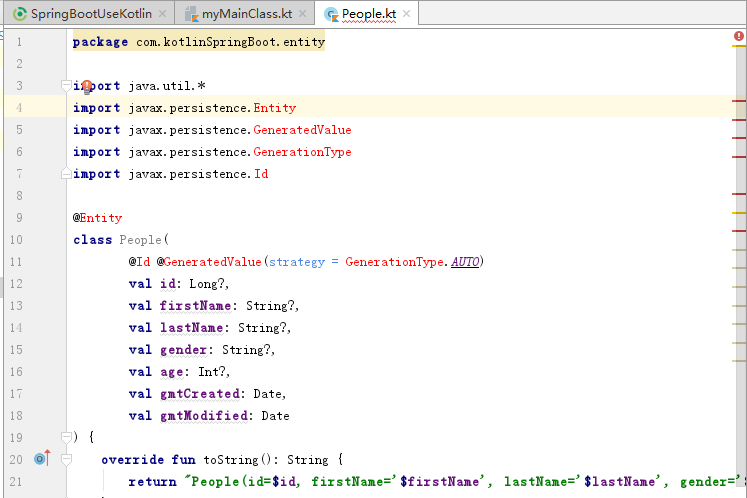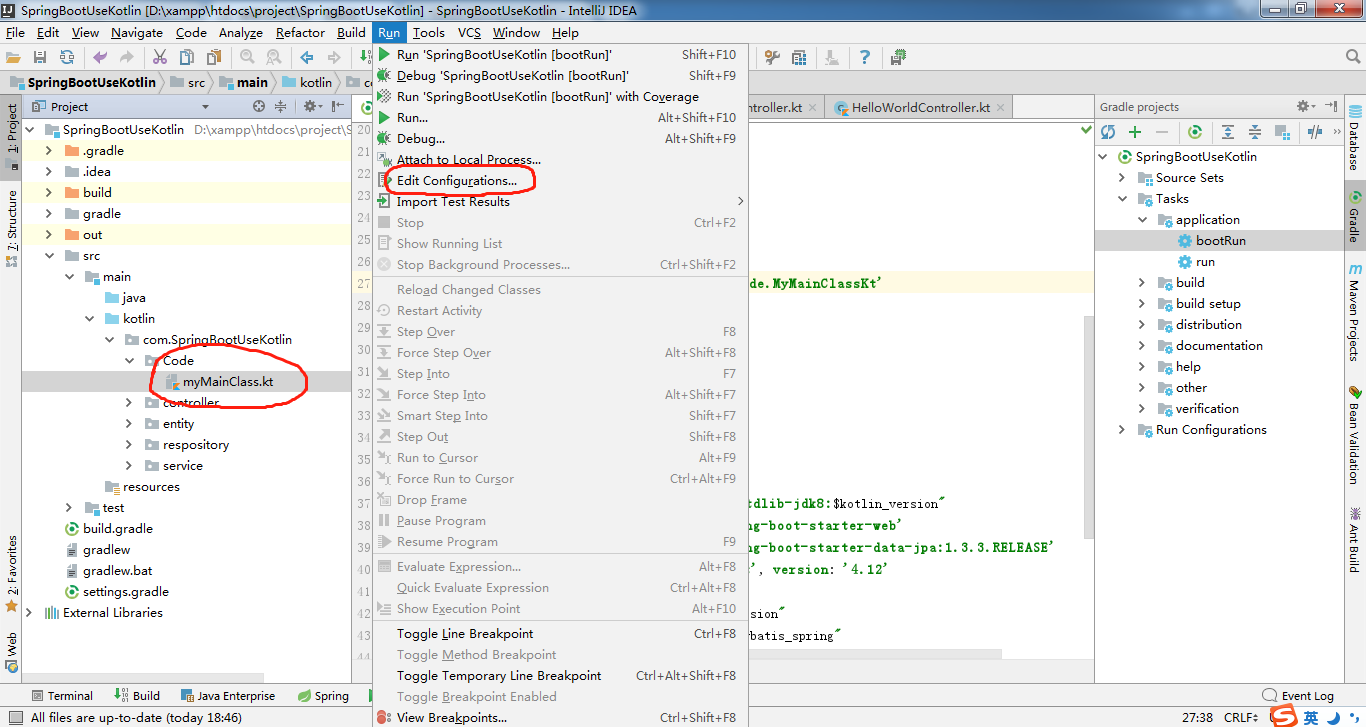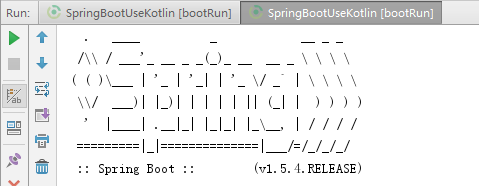根据现在的开发模式和网上的一些资料,SpringBoot需要对业务和操作进行分层,通常分为controller、entity、service、respository等结构。下面以Kotlin官网的例子,讲解在分层的时候,需要做什么配置。
1、在包com.SpringBootUseKotlin中新建包entity,添加新的class,命名为People
package com.kotlinSpringBoot.entity
import java.util.*
import javax.persistence.Entity
import javax.persistence.GeneratedValue
import javax.persistence.GenerationType
import javax.persistence.Id
@Entity
class People(
@Id @GeneratedValue(strategy = GenerationType.AUTO)
val id: Long?,
val firstName: String?,
val lastName: String?,
val gender: String?,
val age: Int?,
val gmtCreated: Date,
val gmtModified: Date
) {
override fun toString(): String {
return "People(id=$id, firstName='$firstName', lastName='$lastName', gender='$gender', age=$age, gmtCreated=$gmtCreated, gmtModified=$gmtModified)"
}
}
根据官网写的代码,结果却标红了:

因为上面的代码使用了JPA,但是没有引入相关的文件,在build.gradle中的dependencies添加相应的依赖即可解决该错误:
compile 'org.springframework.boot:spring-boot-starter-data-jpa:1.3.3.RELEASE'
2、在包com.SpringBootUseKotlin中新建包respository,新增class,命名为:PeopleRepository
package com.kotlinSpringBoot.repository
import com.kotlinSpringBoot.entity.People
import org.springframework.data.repository.CrudRepository
interface PeopleRepository : CrudRepository<People, Long> {
fun findByLastName(lastName: String): List<People>?
}
3、在包com.SpringBootUseKotlin中新建包service,新增class,命名为:PeopleService
package com.kotlinSpringBoot.service
import com.kotlinSpringBoot.entity.People
import com.kotlinSpringBoot.repository.PeopleRepository
import org.springframework.beans.factory.annotation.Autowired
import org.springframework.stereotype.Service
class PeopleService {
@Autowired
val peopleRepository: PeopleRepository? = null
fun findByLastName(lastName: String): List<People>? {
return peopleRepository?.findByLastName(lastName)
}
fun <S : People?> save(entity: S): S? {
return peopleRepository?.save(entity)
}
fun <S : People?> save(entities: MutableIterable<S>?): MutableIterable<S>? {
return peopleRepository?.save(entities)
}
fun delete(entities: MutableIterable<People>?) {
}
fun delete(entity: People?) {
}
fun delete(id: Long?) {
}
fun findAll(ids: MutableIterable<Long>?): MutableIterable<People>? {
return peopleRepository?.findAll(ids)
}
fun findAll(): MutableIterable<People>? {
return peopleRepository?.findAll()
}
fun exists(id: Long?): Boolean {
return peopleRepository?.exists(id)!!
}
fun count(): Long {
return peopleRepository?.count()!!
}
fun findOne(id: Long?): People? {
return peopleRepository?.findOne(id)
}
fun deleteAll() {
}
}
4、在包com.SpringBootUseKotlin中新建包controller,新增class,命名为:PeopleController
package com.kotlinSpringBoot.controller
import com.kotlinSpringBoot.service.PeopleService
import org.springframework.beans.factory.annotation.Autowired
import org.springframework.stereotype.Controller
import org.springframework.web.bind.annotation.GetMapping
import org.springframework.web.bind.annotation.RequestParam
import org.springframework.web.bind.annotation.ResponseBody
@Controller
class PeopleController {
@Autowired
val peopleService: PeopleService? = null
@GetMapping(value = "/hello")
@ResponseBody
fun hello(@RequestParam(value = "lastName") lastName: String): Any {
val peoples = peopleService?.findByLastName(lastName)
val map = HashMap<Any, Any>()
map.put("hello", peoples!!)
return map
}
}
在controller包内新增类HelloWorldController
package com.kotlinSpringBoot.controller
import org.springframework.web.bind.annotation.GetMapping
import org.springframework.web.bind.annotation.RestController
@RestController
class HelloWorldController {
@GetMapping(value = *arrayOf("/helloworld", "/"))
fun helloworld(): Any {
return "Hello,World!"
}
}
分层结束,下面说一下执行主类的另一种方法

点击图中的bootrun运行程序,报错:没有指定的主类myMainClass。上一节中我们建立了主类,如下:
package com.SpringBootUseKotlin.Code
import org.springframework.boot.SpringApplication
import org.springframework.boot.autoconfigure.SpringBootApplication
@SpringBootApplication
open class myMainClass{
}
fun main(args:Array<String>){
SpringApplication.run(myMainClass::class.java, *args)
}
我们在build.gradle里加上mainClassName属性。注意,mainClassName依赖于插件application,如果报错说该属性未定义,则在build.gradle中添加:
apply plugin: 'application'
那么这个属性的值是多少呢?这个类名是myMainClass,那么mainClassName的值是否为:com.SpringBootUseKotlin.Code.MyMainClass ?其实并不是。
我们可以通过下面的操作查看到类的名称(点击主类,在Run的菜单中选择设置):


所以真正的mainClassName应该设置为com.SpringBootUseKotlin.Code.MyMainClassKt,注意,后面多了个Kt。
设了类名之后,需要在主类中加上注解:
package com.kotlinSpringBoot import org.springframework.boot.SpringApplication import org.springframework.boot.autoconfigure.SpringBootApplication
//注解MapperScan需要import该jar包
import org.mybatis.spring.annotation.MapperScan;
@SpringBootApplication @MapperScan("com.kotlinSpringBoot.mapper") //这个是刚加的注解,以便主类可以被扫描到
open class Application {
}
fun main(args: Array<String>) {
SpringApplication.run(Application::class.java, *args)
}
上面的代码中,需要引入org.mybatis.spring.annotation.MapperScan,因此需要在build.gradle的配置文件中增加下面的配置:
buildscript {
ext.mybatisVersion = '3.3.1'
ext.mybatis_spring = '1.2.5'
}
dependencies {
compile "org.mybatis:mybatis:$mybatisVersion"
compile "org.mybatis:mybatis-spring:$mybatis_spring"
}
配置完成后再点击一次gradle的bootrun,则可以看到下面的输出了:
